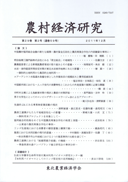Volume 35, Issue 1
JOURNAL OF RURAL SOCIETY AND ECONOMICS
Displaying 1-19 of 19 articles from this issue
- |<
- <
- 1
- >
- >|
cover
-
2017Volume 35Issue 1 Pages 0
Published: July 01, 2017
Released on J-STAGE: September 01, 2021
Download PDF (97K)
PROCEEDINGS FROM THE ANNUAL MEETING 2016 Responses of farmer and consumer to Trans-Pacific Partnership agreement
-
2017Volume 35Issue 1 Pages 1-2
Published: July 01, 2017
Released on J-STAGE: September 01, 2021
Download PDF (321K) -
2017Volume 35Issue 1 Pages 3-8
Published: July 01, 2017
Released on J-STAGE: September 01, 2021
Download PDF (845K) -
2017Volume 35Issue 1 Pages 9-17
Published: July 01, 2017
Released on J-STAGE: September 01, 2021
Download PDF (1293K) -
2017Volume 35Issue 1 Pages 18-22
Published: July 01, 2017
Released on J-STAGE: September 01, 2021
Download PDF (616K) -
2017Volume 35Issue 1 Pages 23-26
Published: July 01, 2017
Released on J-STAGE: September 01, 2021
Download PDF (545K) -
2017Volume 35Issue 1 Pages 27-29
Published: July 01, 2017
Released on J-STAGE: September 01, 2021
Download PDF (325K) -
2017Volume 35Issue 1 Pages 30-38
Published: July 01, 2017
Released on J-STAGE: September 01, 2021
Download PDF (3417K) -
2017Volume 35Issue 1 Pages 39-48
Published: July 01, 2017
Released on J-STAGE: September 01, 2021
Download PDF (1104K) -
2017Volume 35Issue 1 Pages 49-50
Published: July 01, 2017
Released on J-STAGE: September 01, 2021
Download PDF (260K)
Articles
-
Article type: research-article
2017Volume 35Issue 1 Pages 51-58
Published: July 01, 2017
Released on J-STAGE: September 01, 2021
Download PDF (1158K) -
Article type: research-article
2017Volume 35Issue 1 Pages 59-66
Published: July 01, 2017
Released on J-STAGE: September 01, 2021
Download PDF (1045K) -
Article type: research-article
2017Volume 35Issue 1 Pages 67-74
Published: July 01, 2017
Released on J-STAGE: September 01, 2021
Download PDF (1171K) -
Article type: research-article
2017Volume 35Issue 1 Pages 75-83
Published: July 01, 2017
Released on J-STAGE: September 01, 2021
Download PDF (1192K) -
Article type: research-article
2017Volume 35Issue 1 Pages 84-91
Published: July 01, 2017
Released on J-STAGE: September 01, 2021
Download PDF (908K) -
Article type: research-article
2017Volume 35Issue 1 Pages 92-100
Published: July 01, 2017
Released on J-STAGE: September 01, 2021
Download PDF (1106K) -
Article type: research-article
2017Volume 35Issue 1 Pages 101-109
Published: July 01, 2017
Released on J-STAGE: September 01, 2021
Download PDF (2295K) -
Article type: research-article
2017Volume 35Issue 1 Pages 110-117
Published: July 01, 2017
Released on J-STAGE: September 01, 2021
Download PDF (1289K)
Back cover
-
2017Volume 35Issue 1 Pages 118-119
Published: July 01, 2017
Released on J-STAGE: September 01, 2021
Download PDF (269K)
- |<
- <
- 1
- >
- >|
